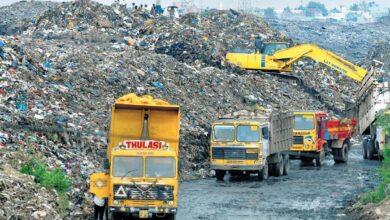Overflowing river systems are taking a toll amid heavy rainfall
The stories of four significant river basins and river systems—the Ravi, Beas, Sutlej, and Ganga—are interwoven in the floods that have devastated sections of north India. These river systems, the majority of which are in spate owing to very high rain in catchment regions, have all swamped the most afflicted states. Even if this is the main reason for the floods, the problem has been made worse by a lack of planning and preparedness and, in the case of the hill states, indiscriminate development.

basin of the River Vi
Several downstream regions in Jammu, Gurdaspur, and Kapurthala in Punjab have been flooded as a consequence of the Ravi river’s source districts of Chamba and Kangra receiving heavy rainfall. At least 600 mm of rain had fallen in the Ravi river basin region since Friday, according to estimates. At 5.30 p.m. on Monday, Ghamroor in Kangra broke the old record of 166 mm of rain in 24 hours established in 2006.
Heavy rains produced landslides that closed a number of connection roads in the districts of Kangra and Chamba, including those that led to the well-known hill town of Dharamshala, which is located in the river basin. Due to the torrential rains that also swept away a piece of the Jammu-Srinagar highway, the Ujh river in Jammu, which serves as a feeder to the Ravi, was overflowing.
The Ravi’s level is increasing at a “alarming” pace, prompting the Punjab Irrigation Department to issue a flood notice for the Majha area on Monday. According to Punjab’s irrigation minister, Kuldeep Singh Dhaliwal, residents have been informed that they may need to evacuate if the water level rises further.
As the gates of numerous barrages on the river have been opened to release extra water, the Pakistani disaster management body has issued a flood warning for towns in the Ravi basin, including Rawalpindi and Lahore, expecting a rise in water levels.
Bed of the Beas River
Since Thursday, the Kullu area of Himachal has had close to 950 mm of precipitation, flooding the Beas and its principal tributaries including the Parbati. The Beas, in the Seraj assembly seat of former chief minister Jairam Thakur, provided the most spectacular footage of the rains, showing a hotel in Manali, automobiles parked along a monsoon steam in Kasol, and logs in a forest store in Thunag all being carried away. The Beas River is running dangerously near to the danger line in Mandi in Himachal and numerous other locations in Punjab.
An official said that “a private hotel fell into the Ravi as quickly gushing water washed away the retaining wall on which the hotel was built.” In order to meet visitor demand, hundreds of hotels and structures have sprung up beside rivers and streams in Manali and the surrounding regions, paying little attention to the local ecosystem or natural water flow patterns.
Additionally, the Manali-Kullu highway washed down right before Mandi town, leaving hundreds of visitors stuck. Sukhwinder Singh Sukhu, the chief minister of Himachal, said that bridges had been swept away in Kullu and that the Largi power facility had been flooded. According to authorities, there are around 300 persons trapped in different locations across the mountainous state.
Sutlej river network
Sutlej, which rises in China and flows through the districts of Kinnaur, Shimla, Kullu, Mandi, and Bilaspur before entering Punjab at Ropar, is under flood in its upper catchment regions due to severe rainfall. Kahu in Bilaspur broke the previous record for the most rainfall in 2004 with 171.5 mm of rain in 24 hours as of Monday.
As a result of Monday’s breaching of the “Dhussi Bandh” (a makeshift embankment along the river), water from the Sutlej flooded the Punjab Police Training Academy in Phillaur. According to authorities, about 100 villages around Ghaggar and Badi Nadi in Devigarh, Sanaur, and Balbera are flooded.
On Monday, an estimated 2.50 lakh cusecs of water were anticipated to enter the Sutlej. From Ropar, around 1.50 lakh cusecs of water had been discharged. According to authorities, residents of a few villages in the Jalandhar district have already been relocated to relief camps. Additionally, residents of the other villages along the Sutlej’s banks have been placed on high alert. According to Vishesh Sarangal, the deputy commissioner of Jalandhar, every precaution has been taken, and the situation is being continuously monitored.
Gaggar, a monsoon river that flows into the Sutlej water system, has caused floods in Pinjore, Panchkula, Patiala, and other regions as a result of high rainfall in the Himachal district of Solan. Massive landslides blocked the Dharampur-Kasauli and Shimla-Chandigarh highways in several locations. Videos of automobiles floating down in the Solan district’s industrial town of Parwanoo have gone viral. Solan got 135 mm of rain up until Monday morning, shattering the previous record of 105 mm set in 1971 that stood for 52 years. The area has seen the most rain ever in a 72-hour period with 380 mm of rain falling since Friday.
The Gaggar basin’s tri-city of Chandigarh, Panchkula, and Mohali got more than 531.6 mm of rain in under 72 hours, the most since 1953. Water delivery to the whole city would be disrupted for a few days due to damage to one of the four pipes that transport drinking water from the Bhakra main line canal to Chandigarh.
Patiala and several other places along the banks of the Gaggar River were also said to have experienced flooding. The Tiwana village of Mohali has requested the assistance of the National Disaster Response Force. The 10-foot danger threshold is being crossed by water running at 12.5 feet, according to chief irrigation engineer H S Mehndiratta.
river basin
The Ganga and Yamuna, which both come from Uttarakhand, were often running near to the danger level.
The national river was running at 454.76 m at Devprayag, where the Alaknanda and Bhagirathi holy rivers unite to create the Ganga, while the danger threshold is 463 m, according to the Central Water Commission. The Ganga was flowing in Rishikesh at 338.32 metres on Monday, whereas the danger level is 340.5 metres. As rain continues in upper altitudes, “the water level is rising at most places,” stated State Disaster Management official Ranjit Kumar Sinha. In Haridwar, a number of other Ganga tributaries, including the Solani River and the Banganga (Raisi River), were also running dangerously near to the danger threshold.
The Yamuna was flowing in Uttarkashi on Monday at 1059.20 m, whereas the danger threshold is 1060.00 m. Authorities in Haryana have issued a flood warning for the districts of Yamunanagar, Karnal, Panipat, and Sonepat due to 3.09 cusec of water entering the river. According to authorities, water reached agricultural areas in the districts of Karnal and Yamunanagar.
“Flows between 70,000 cusecs and 1.5 lakh cusecs are considered low floods, flows between 1.5 lakh cusecs and 2.5 lakh cusecs are called medium floods, and flows above 2.5 lakh cusecs are considered high floods,” a representative of the Haryana irrigation department said. From the Hathinikund barrage, more water is being released into the Yamuna, and it would take two to three days for it to reach the city.







